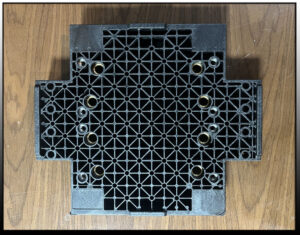Carbon nanotube-reinforced conductive compound is a composite material with good conductive properties made of carbon nanotubes as reinforcing fillers and compounded with resin. Carbon nanotubes are several times stronger than steel while being lightweight, making them an ideal reinforcement material to increase the strength and stiffness of composite materials. In conductive compounds, carbon nanotubes are evenly dispersed in resins, etc., and are connected or close to each other to form a three-dimensional conductive network. When an electric current passes through them, electrons can be transported quickly along the carbon nanotubes’ conductive network, significantly increasing the material’s conductivity. Compared with traditional conductive fillers (such as carbon black, conductive graphite, etc.), carbon nanotubes can achieve good conductive effects at a lower dosage due to their high aspect ratio and excellent conductive properties.
Carbon nanotube-reinforced conductive compounds have many advantages, mainly including the following aspects:

Excellent mechanical properties
- High strength: Carbon nanotubes have extremely high axial strength, which can be 100 times or even higher than steel. Incorporating it into the compounds can greatly improve both the tensile and compressive strength of the material. It can be used to manufacture structural parts that require high material strength, such as parts in the aerospace field, high-performance sports equipment, etc.
- High modulus: Carbon nanotubes also have a high modulus, meaning they are less prone to deformation when force is applied. This can improve the stiffness of the conductive compound, allowing it to maintain better shape stability when subjected to external forces, which is very important for application scenarios that require maintaining high-precision dimensions, such as housings for precision instruments, brackets for optical equipment, etc.
- Good toughness and bendability: Carbon nanotubes have good toughness and bendability, and can absorb energy to a certain extent and withstand large deformations without breaking. This characteristic can make the carbon nanotube-reinforced conductive compound more resistant to damage when subjected to shock or vibration, increasing the compound’s reliability and service life.
Unique electrical properties
- High electrical conductivity: Carbon nanotubes have excellent electrical conductivity, and the electrical conductivity of some carbon nanotubes is even better than that of copper. Integrating carbon nanotubes into the compound can establish a conductive network, significantly enhancing the material’s conductivity. This makes carbon nanotube conductive compounds widely used in conductive materials, such as conductive cores of wires and cables, electrode materials for electronic equipment, electromagnetic shielding materials, etc.
- Adjustable conductivity: By changing factors such as the diameter, spiral pattern, and ratio of carbon nanotubes with other materials, the conductivity of carbon nanotube conductive compounds can be adjusted to meet the needs of conductive properties in different application scenarios.
- Semiconductor properties: Some carbon nanotubes have semiconductor properties, which provides the possibility of their application in semiconductor devices. By controlling parameters such as the diameter of carbon nanotubes, their semiconductor properties can be adjusted, and it is expected to be used to manufacture high-performance field effect transistors, logic circuits, and other semiconductor devices, which is of great significance in promoting the development of electronic information technology.
Outstanding thermal properties
- High thermal conductivity: Carbon nanotubes have excellent thermal conductivity, and their thermal conductivity efficiency is much higher than that of ordinary metal materials. Among conductive compounds, carbon nanotubes can serve as efficient thermal conduction channels, quickly transferring heat and helping to improve the material’s heat dissipation efficiency. Therefore, carbon nanotube composite compounds can be used in heat dissipation, such as radiators for electronic equipment, heat dissipation components of engines, etc.
- Good thermal stability: Carbon nanotubes have high thermal stability and are not prone to decomposition or deformation at high temperatures. This enables the carbon nanotube conductive compound to maintain good performance in high-temperature environments and can be used to manufacture parts that work under high-temperature conditions, such as hot-end components of aerospace engines and lining materials for high-temperature furnaces.
Stable chemical properties
- Acid and alkali resistance: Carbon nanotubes have good chemical stability and can withstand erosion by acids, alkalis, and other chemical substances. In harsh chemical environments, such as the chemical industry, batteries, and other fields, carbon nanotube-reinforced conductive compounds can maintain stable chemical performance and extend the service life of the compounds.
- Oxidation resistance: Carbon nanotubes are not easily oxidized and can maintain stable chemical properties in the air. This makes it advantageous in some applications that require high oxidation resistance of materials. For example, in the aerospace field, materials need to be exposed to oxygen for a long time at high altitudes, carbon nanotube-reinforced compounds can meet the requirements of this special environment.
Good processing performance
- Carbon nanotubes can be processed by many methods, such as chemical vapor deposition, arc discharge, laser evaporation, etc. At the same time, it can be combined with various resins (PE, PP, PC, ABS, PPS, PPO, PA6, PA66, PETG) for compounding.




